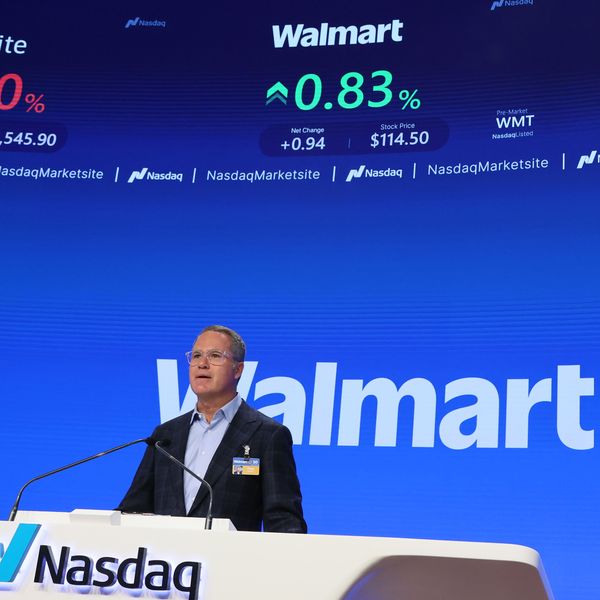
Northrop Grumman's B-21 Raider stealth nuclear bomber is unveiled during a ceremony at the company's Air Force Plant 42 in Palmdale, California, December 2, 2022. (Photo: Frederic J. Brown/AFP via Getty Images)
Supply Chains Woes Didn't Slow Down Global Arms Sales, Analysis Shows
Responding to the report, the U.S.-based group Win Without War said that "our economy prioritizes profits over people, leading to unnecessary violence and death. It makes us less safe."
Sales by the world's 100 leading weapons and military services firms continued to increase last year despite significant supply chain challenges--with the United States accounting for more than half of all sales--an annual analysis published Monday revealed.
Global arms sales rose for the seventh straight year, increasing by 1.9% to $592 billion in 2021, according to new data published by the Stockholm International Peace Research Institute (SIPRI). The rate of growth was higher than the previous year, but still well below the 3.7% average of the four years preceding the Covid-19 pandemic.
SIPRI said that enduring supply chain disruptions caused by the pandemic affected last year's figures.
\u201cThe effects of #Covid-19 pandemic-related shutdowns and restrictions led to supply chain disruptions and shortages in components and labour, which impacted #ArmsIndustry operations in 2021.\n\nNew SIPRI data on the Top 100 arms companies out now \u27a1\ufe0f https://t.co/G4f4y7GJmy\u201d— SIPRI (@SIPRI) 1670235336
"We might have expected even greater growth in arms sales in 2021 without persistent supply chain issues," Lucie Beraud-Sudreau, director of SIPRI's military expenditure and arms production program, said in a statement. "Both larger and smaller arms companies said that their sales had been affected during the year. Some companies, such as Airbus and General Dynamics, also reported labor shortages."
Broken down by country, U.S. companies made up 51% of 2021 sales--a larger share than the next 10 countries combined. U.S. companies made up 40% of SIPRI's top 100 list, with 2021 sales totaling $299 billion--a 0.8% decrease from the previous year attributable to rising inflation. For the fourth consecutive year, the top five firms on SIPRI's list were U.S.-based.
Responding to the report, the U.S.-based peace group Win Without War lamented on Twitter that "our economy prioritizes profits over people, leading to unnecessary violence and death. It makes us less safe."
\u201cWhat is the share of arms sales of the SIPRI Top 100 for 2021 by country?\n\nUSA\ud83c\uddfa\ud83c\uddf8 51%\nChina\ud83c\udde8\ud83c\uddf3 18%\nUK\ud83c\uddec\ud83c\udde7 6.8%\nFrance\ud83c\uddeb\ud83c\uddf7 4.9%\nTrans-European\ud83c\uddea\ud83c\uddfa 3.2%\nRussia\ud83c\uddf7\ud83c\uddfa 3.0%\nItaly\ud83c\uddee\ud83c\uddf9 2.8%\nIsrael\ud83c\uddee\ud83c\uddf1 2.0%\nGermany\ud83c\udde9\ud83c\uddea 1.6%\nJapan\ud83c\uddef\ud83c\uddf5 1.5%\nSouth Korea\ud83c\uddf0\ud83c\uddf7 1.2%\nOther 4.0%\n\n\u27a1\ufe0f https://t.co/G4f4y7p8v0\u201d— SIPRI (@SIPRI) 1670216400
SIPRI said that Russia's invasion of Ukraine "has added to supply chain challenges for arms companies, not least because Russia is a major supplier of raw materials used in arms production."
"This could hamper ongoing efforts in the United States and Europe to strengthen their armed forces and to replenish their stockpiles after sending billions of dollars' worth of ammunition and other equipment to Ukraine," the report states.
An Urgent Message From Our Co-Founder
Dear Common Dreams reader, The U.S. is on a fast track to authoritarianism like nothing I've ever seen. Meanwhile, corporate news outlets are utterly capitulating to Trump, twisting their coverage to avoid drawing his ire while lining up to stuff cash in his pockets. That's why I believe that Common Dreams is doing the best and most consequential reporting that we've ever done. Our small but mighty team is a progressive reporting powerhouse, covering the news every day that the corporate media never will. Our mission has always been simple: To inform. To inspire. And to ignite change for the common good. Now here's the key piece that I want all our readers to understand: None of this would be possible without your financial support. That's not just some fundraising cliche. It's the absolute and literal truth. We don't accept corporate advertising and never will. We don't have a paywall because we don't think people should be blocked from critical news based on their ability to pay. Everything we do is funded by the donations of readers like you. Will you donate now to help power the nonprofit, independent reporting of Common Dreams? Thank you for being a vital member of our community. Together, we can keep independent journalism alive when it’s needed most. - Craig Brown, Co-founder |
Sales by the world's 100 leading weapons and military services firms continued to increase last year despite significant supply chain challenges--with the United States accounting for more than half of all sales--an annual analysis published Monday revealed.
Global arms sales rose for the seventh straight year, increasing by 1.9% to $592 billion in 2021, according to new data published by the Stockholm International Peace Research Institute (SIPRI). The rate of growth was higher than the previous year, but still well below the 3.7% average of the four years preceding the Covid-19 pandemic.
SIPRI said that enduring supply chain disruptions caused by the pandemic affected last year's figures.
\u201cThe effects of #Covid-19 pandemic-related shutdowns and restrictions led to supply chain disruptions and shortages in components and labour, which impacted #ArmsIndustry operations in 2021.\n\nNew SIPRI data on the Top 100 arms companies out now \u27a1\ufe0f https://t.co/G4f4y7GJmy\u201d— SIPRI (@SIPRI) 1670235336
"We might have expected even greater growth in arms sales in 2021 without persistent supply chain issues," Lucie Beraud-Sudreau, director of SIPRI's military expenditure and arms production program, said in a statement. "Both larger and smaller arms companies said that their sales had been affected during the year. Some companies, such as Airbus and General Dynamics, also reported labor shortages."
Broken down by country, U.S. companies made up 51% of 2021 sales--a larger share than the next 10 countries combined. U.S. companies made up 40% of SIPRI's top 100 list, with 2021 sales totaling $299 billion--a 0.8% decrease from the previous year attributable to rising inflation. For the fourth consecutive year, the top five firms on SIPRI's list were U.S.-based.
Responding to the report, the U.S.-based peace group Win Without War lamented on Twitter that "our economy prioritizes profits over people, leading to unnecessary violence and death. It makes us less safe."
\u201cWhat is the share of arms sales of the SIPRI Top 100 for 2021 by country?\n\nUSA\ud83c\uddfa\ud83c\uddf8 51%\nChina\ud83c\udde8\ud83c\uddf3 18%\nUK\ud83c\uddec\ud83c\udde7 6.8%\nFrance\ud83c\uddeb\ud83c\uddf7 4.9%\nTrans-European\ud83c\uddea\ud83c\uddfa 3.2%\nRussia\ud83c\uddf7\ud83c\uddfa 3.0%\nItaly\ud83c\uddee\ud83c\uddf9 2.8%\nIsrael\ud83c\uddee\ud83c\uddf1 2.0%\nGermany\ud83c\udde9\ud83c\uddea 1.6%\nJapan\ud83c\uddef\ud83c\uddf5 1.5%\nSouth Korea\ud83c\uddf0\ud83c\uddf7 1.2%\nOther 4.0%\n\n\u27a1\ufe0f https://t.co/G4f4y7p8v0\u201d— SIPRI (@SIPRI) 1670216400
SIPRI said that Russia's invasion of Ukraine "has added to supply chain challenges for arms companies, not least because Russia is a major supplier of raw materials used in arms production."
"This could hamper ongoing efforts in the United States and Europe to strengthen their armed forces and to replenish their stockpiles after sending billions of dollars' worth of ammunition and other equipment to Ukraine," the report states.
Sales by the world's 100 leading weapons and military services firms continued to increase last year despite significant supply chain challenges--with the United States accounting for more than half of all sales--an annual analysis published Monday revealed.
Global arms sales rose for the seventh straight year, increasing by 1.9% to $592 billion in 2021, according to new data published by the Stockholm International Peace Research Institute (SIPRI). The rate of growth was higher than the previous year, but still well below the 3.7% average of the four years preceding the Covid-19 pandemic.
SIPRI said that enduring supply chain disruptions caused by the pandemic affected last year's figures.
\u201cThe effects of #Covid-19 pandemic-related shutdowns and restrictions led to supply chain disruptions and shortages in components and labour, which impacted #ArmsIndustry operations in 2021.\n\nNew SIPRI data on the Top 100 arms companies out now \u27a1\ufe0f https://t.co/G4f4y7GJmy\u201d— SIPRI (@SIPRI) 1670235336
"We might have expected even greater growth in arms sales in 2021 without persistent supply chain issues," Lucie Beraud-Sudreau, director of SIPRI's military expenditure and arms production program, said in a statement. "Both larger and smaller arms companies said that their sales had been affected during the year. Some companies, such as Airbus and General Dynamics, also reported labor shortages."
Broken down by country, U.S. companies made up 51% of 2021 sales--a larger share than the next 10 countries combined. U.S. companies made up 40% of SIPRI's top 100 list, with 2021 sales totaling $299 billion--a 0.8% decrease from the previous year attributable to rising inflation. For the fourth consecutive year, the top five firms on SIPRI's list were U.S.-based.
Responding to the report, the U.S.-based peace group Win Without War lamented on Twitter that "our economy prioritizes profits over people, leading to unnecessary violence and death. It makes us less safe."
\u201cWhat is the share of arms sales of the SIPRI Top 100 for 2021 by country?\n\nUSA\ud83c\uddfa\ud83c\uddf8 51%\nChina\ud83c\udde8\ud83c\uddf3 18%\nUK\ud83c\uddec\ud83c\udde7 6.8%\nFrance\ud83c\uddeb\ud83c\uddf7 4.9%\nTrans-European\ud83c\uddea\ud83c\uddfa 3.2%\nRussia\ud83c\uddf7\ud83c\uddfa 3.0%\nItaly\ud83c\uddee\ud83c\uddf9 2.8%\nIsrael\ud83c\uddee\ud83c\uddf1 2.0%\nGermany\ud83c\udde9\ud83c\uddea 1.6%\nJapan\ud83c\uddef\ud83c\uddf5 1.5%\nSouth Korea\ud83c\uddf0\ud83c\uddf7 1.2%\nOther 4.0%\n\n\u27a1\ufe0f https://t.co/G4f4y7p8v0\u201d— SIPRI (@SIPRI) 1670216400
SIPRI said that Russia's invasion of Ukraine "has added to supply chain challenges for arms companies, not least because Russia is a major supplier of raw materials used in arms production."
"This could hamper ongoing efforts in the United States and Europe to strengthen their armed forces and to replenish their stockpiles after sending billions of dollars' worth of ammunition and other equipment to Ukraine," the report states.

